Endangered Species Statistics By Number Of Threatened Wildlife And Plant Species In The USA

Updated · Mar 10, 2025


TABLE OF CONTENTS
- Introduction
- Editor’s Choice
- General Endangered Species Statistics
- Top 5 Biggest Mass Extinctions In Geological History
- Endangered Species Statistics By Number Of Threatened Wildlife And Plant Species In The USA
- Endangered Species Statistics By IUCN Red List 2023
- Endangered Species Statistics By Discoveries Vs. Threatened Species By Types Of Organisms
- Endangered Species Statistics By Risk Of Species Extinction Worldwide Due to Global Warming
- Endangered Species Statistics By Share Of Ecosystems At Risk In The USA By Type
- The Attitude Of Americans Toward Environmental Causes In 2023
- Endangered Species Statistics By Number Of Endangered Wildlife And Plant Species In 2023
- Endangered Species Statistics By Worldwide Share Of Living Species Threatened To Extinction
- Endangered Species Statistics By Threats To Wildlife Populations By Region
- Endangered Species Statistics By Critically Endangered Species List
- What Are The Reasons Behind Species Extinction?
- Conclusion
Introduction
Endangered Species Statistics: As humans, we tend to believe that civilization, industrialization, and modernization are the best ways to live life. As a result, we search for areas where infrastructure can be built and modern life can be started. However, we often unknowingly destroy the habitats of animals in the process. This is not just a problem in developed countries, but it happens all over the world.
Although there are many initiatives taken by wildlife and environment lovers to protect plant and animal species, it is not enough. The endangered species statistics show how dangerous the world has become for animals and plants. In the majority of cases, a huge number of species are on the verge of extinction.
Editor’s Choice
- 77% of Cheetahs live in areas where humans easily come and go and thus are dangerously threatened.
- In the USA in 2023, 174 plants, 78 species of fishes, and 29 species of mammals were likely to be threatened in the coming future.
- Human activities have caused the surface of the ocean to change 66%.
- According to Science News, oceans are the largest habitats for various animals and plants.
- Around the world, as of today, 74,962 vertebrate and 1,480,351 invertebrate species have been discovered, of which 11,195 vertebrates and 6,221 invertebrates have been identified on the Red List of threatened species in 2023.
- In 2023, the top 3 high-risk ecosystems in the USA were tropical forests, tropical high montane grasslands and shrublands, and tropical cliffs and open rock with a 100% rate of risk.
- One-third of shark and ray species are almost extinct. The endangered species of shark include the giant manta ray, four hammerhead shark species, and four angel shark species.
- Unfortunately, just for winning and trophy purposes, hunters kill more than 200,000 animals.
- Other species in the list of most endangered wildlife and plant species included birds (77), insects (76), mammals (67), snails (38), crustaceans (25), amphibians (23), reptiles (11) and arachnids (11).
- Polar bears are not only threatened by climate change but oil and gas industries are also becoming a problem in the Arctic.
- Climate change, hunting or poaching, coastal development, pollution, and fisheries are causing 6 out of 7 sea turtle species to be endangered.
You May Also Like To Read
- Food Waste Statistics
- Globalization Statistics
- Climate Change Statistics
- Statistics About Flooding And Water Damage in The USA
- Reusable Water Bottle Statistics
- Electric Vehicle Statistics
- Gun Violence Statistics
General Endangered Species Statistics
- According to Endangered Species Statistics, the current extinction rate is 1,000 to 10,000 times more as compared to the natural rate.
- Furthermore, plants go extinct at a rate of 500 times more as compared to the natural rate.
- Every year, between 200 to 2,000 extinction events take place.
- Since the last 250 years, the number of confirmed extinct species is 571.
- Unfortunately, just for winning and trophy purposes, hunters kill more than 200,000 animals.
- Only 1 out of 19 subpopulations of polar bears, has seen to increase.
- Human activities have caused the surface of the ocean to change 66%. According to Science News, oceans are the largest habitats for various animals and plants.
- Endangered Species Statistics state that by 2026 red wolves are likely to go extinct.
- Polar bears are not only threatened by climate change but oil and gas industries are also becoming a problem in the Arctic.
- Furthermore, habitat loss for pandas is majorly threatened by industrialization.
- 77% of Cheetahs live in areas where humans easily come and go and thus are dangerously threatened.
- Since 1011, the black rhino has gone extinct.
- Endangered Species Statistics state that if bees go extinct, it will lead to a chain reaction damaging nature, society, and animals and plants.
- 40% and above amphibians are endangered because of human activities.
- One-third of shark and ray species are almost extinct. The endangered species of shark include the giant manta ray, four hammerhead shark species, and four angel shark species.
- Climate change, hunting or poaching, coastal development, pollution, and fisheries are causing 6 out of 7 sea turtle species to be endangered.
- According to IUCN, 41,000+ species are on the verge of extinction.
- Today, in 99% of cases, humans are responsible for endangered species.
- Furthermore, 9,000+ species are critically endangered, according to the IUCN list.
- The population of amphibians, reptiles, birds, fishes, and mammals have been significantly decreased by 68% since 1970.
- According to Endangered Species Statistics, out of all species that ever lived in history since the birth of our blue planet, only 2% are alive today.
- According to the scientists, we are living in a 6th mass extinction.
- The population of the African elephant is been reduced by 50%.
- A Rhino is killed in South Africa every 22 hours.
- As of today, there are less than 5,000 eastern gorillas around the world making them critically endangered by the IUCN red list.
- According to the American Cetacean Society, only 10,000 to 25,000 blue whales are left in the world.
- In the last 25 years, the Sumatran elephant population has been reduced by 80%.
- As per Conservation International, 60% of primate species are on the verge of extinction.
- Endangered Species Statistics show the number of species left today in the world: –
- Red Pandas – less than 10,000
- Vaquita porpoises – less than 30
- Javan rhinos – less than 60
- Philippine eagles – around 2,000
- Giant pandas – 1,816
- Pink pigeon – 400
- Amur Leopards – less than 1,000
- Ganges river dolphins – 2,200
- Cheetahs – less than 7,000
- Sumatran rhinos – less than 80
- Mountain gorillas – less than 1,000
- Out of 8,300 known species of animals, 22% are endangered and 8% are extinct.
- In the coming years, the 12 most endangered wildlife species are polar bear, panda, elephant, whale, chimpanzee, mountain gorilla, snow leopard, tiger of Sumatra, rhinoceros, turtles, freshwater dolphin, and whale shark.
Top 5 Biggest Mass Extinctions In Geological History
- Cretaceous-Tertiary Extinction: happened 65 million years ago – what went extinct?
- Ammonoids (marine mollusks)
- Mosasaurs (swimming reptiles)
- Pterosaurs (gliding reptiles)
- Triassic-Jurrasic extinction: happened 210 million years ago – what went extinct?
- Archosauromorphs
- Crocodylomorphs
- Pterosaur
- Dinosaurs (vertebrate species went extinct)
- Permian-Triassic Extinction: happened 250 million years ago – what went extinct?
286 out of 329 marine invertebrates - Devonian Extinction: happened 365 million years ago – what went extinct?
- Stromatogoroids
- Rugose corals
- Trilobites
- Brachiopods
- Ordovician-Silurian extinction: happened 440 million years ago – what went extinct?
Bryozoan families and groups of trilobites, corals, conodonts, graptolites, bivalves, and
echinoderms
Endangered Species Statistics By Number Of Threatened Wildlife And Plant Species In The USA
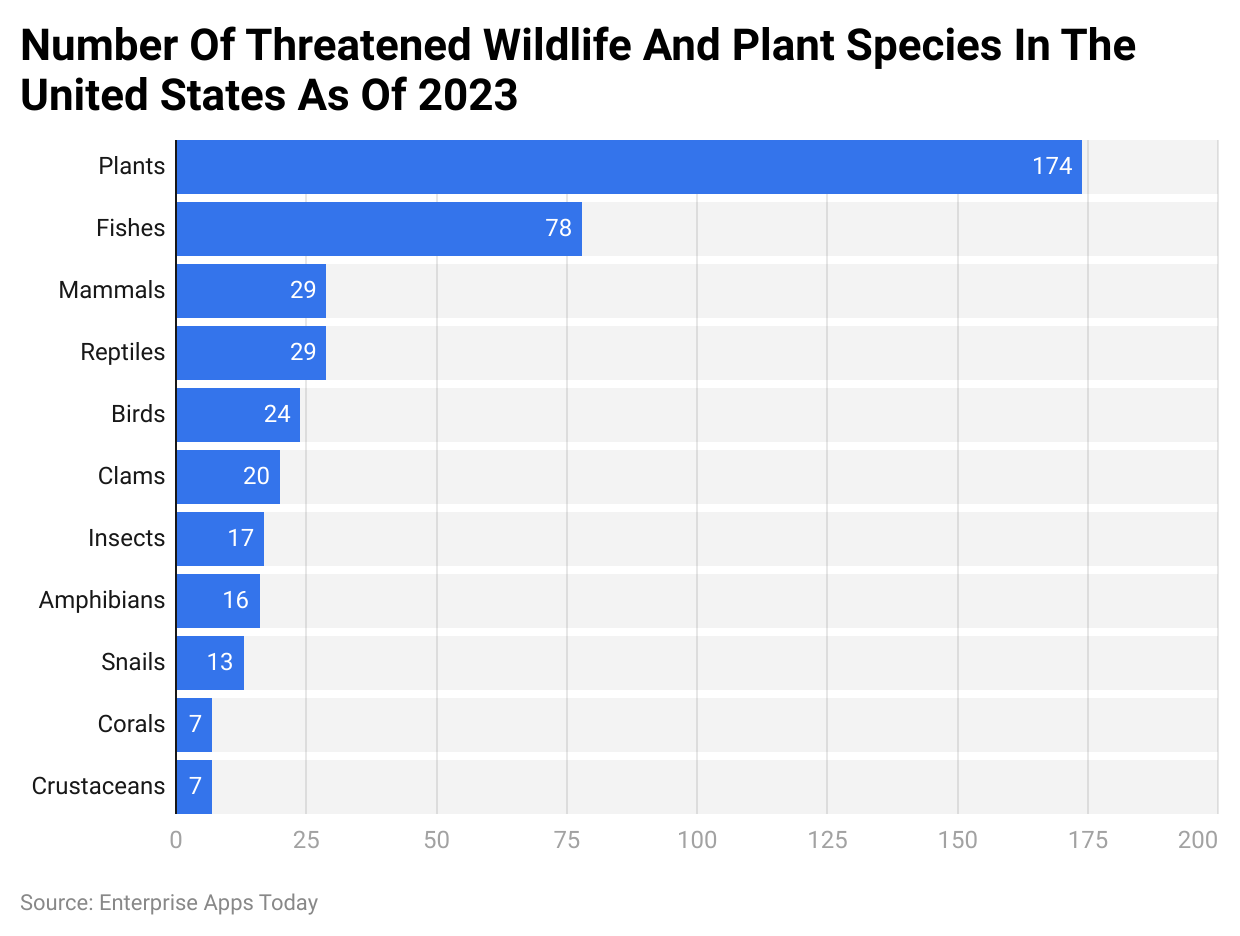 (Reference: statista.com)
(Reference: statista.com)
- Endangered Species Statistics 2023 state that in the USA in the mentioned year, 174 plants, 78 species of fishes, and 29 species of mammals were likely to be threatened in the coming future.
- Other endangered list of plants and wildlife species included reptiles (29), birds (24), clams (20), insects (17), amphibians (16), snails (13), corals and crustaceans (7).
Endangered Species Statistics By IUCN Red List 2023
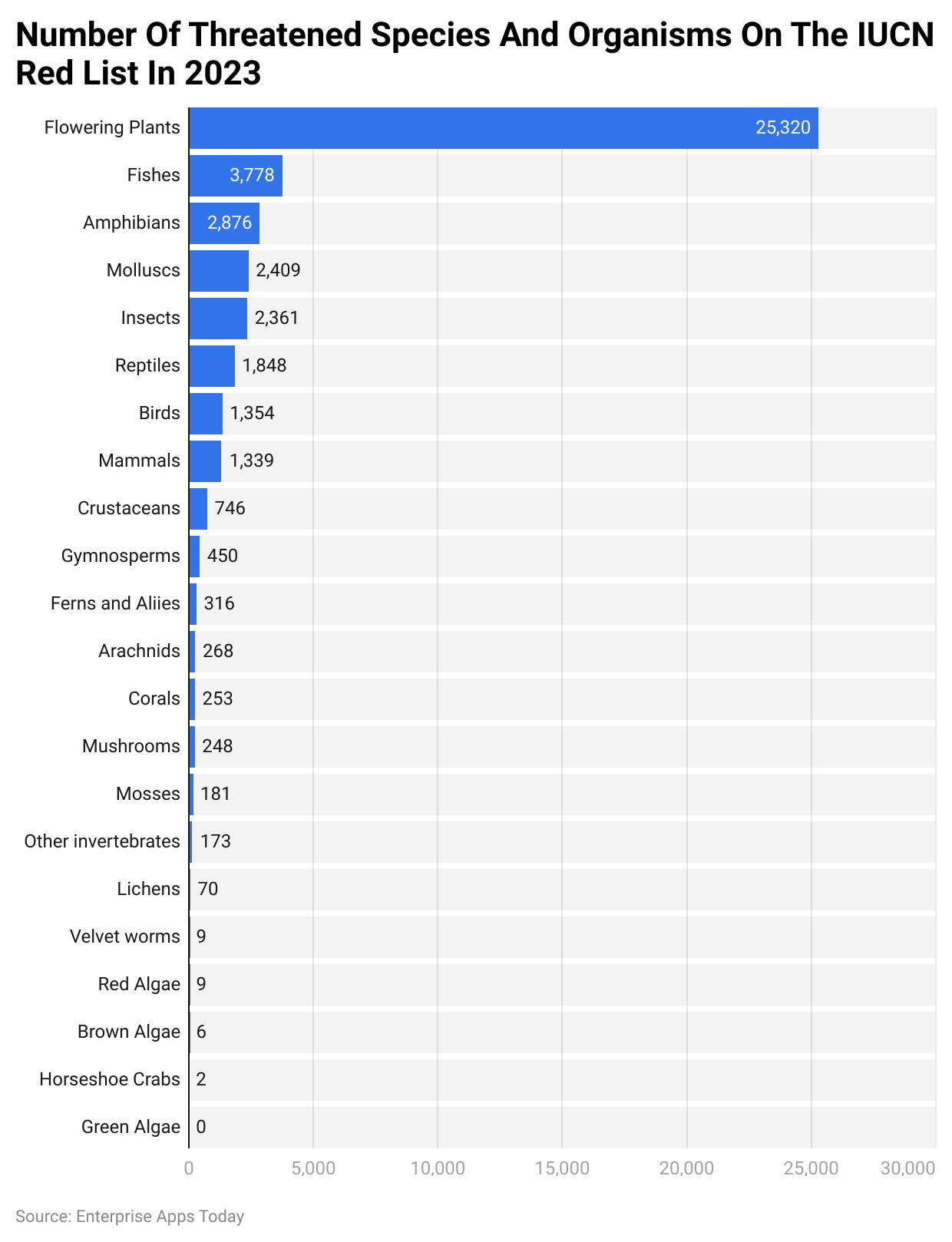 (Reference: statista.com)
(Reference: statista.com)
- According to the IUCN Red List 2023, more than 25,000 species of flowering plants are likely to be extinct in the near future.
- The list also adds 3,778 species of fish, 2,876 amphibians, 2,409 molluscs, and 2,361 insect species in the top 5.
- Furthermore, Reptiles, birds, and mammals have more than 1,000 species that are currently endangered. While crustaceans, gymnosperms, ferns and allies, arachnids, corals, etc have been mentioned for a similar reason.
Endangered Species Statistics By Discoveries Vs. Threatened Species By Types Of Organisms
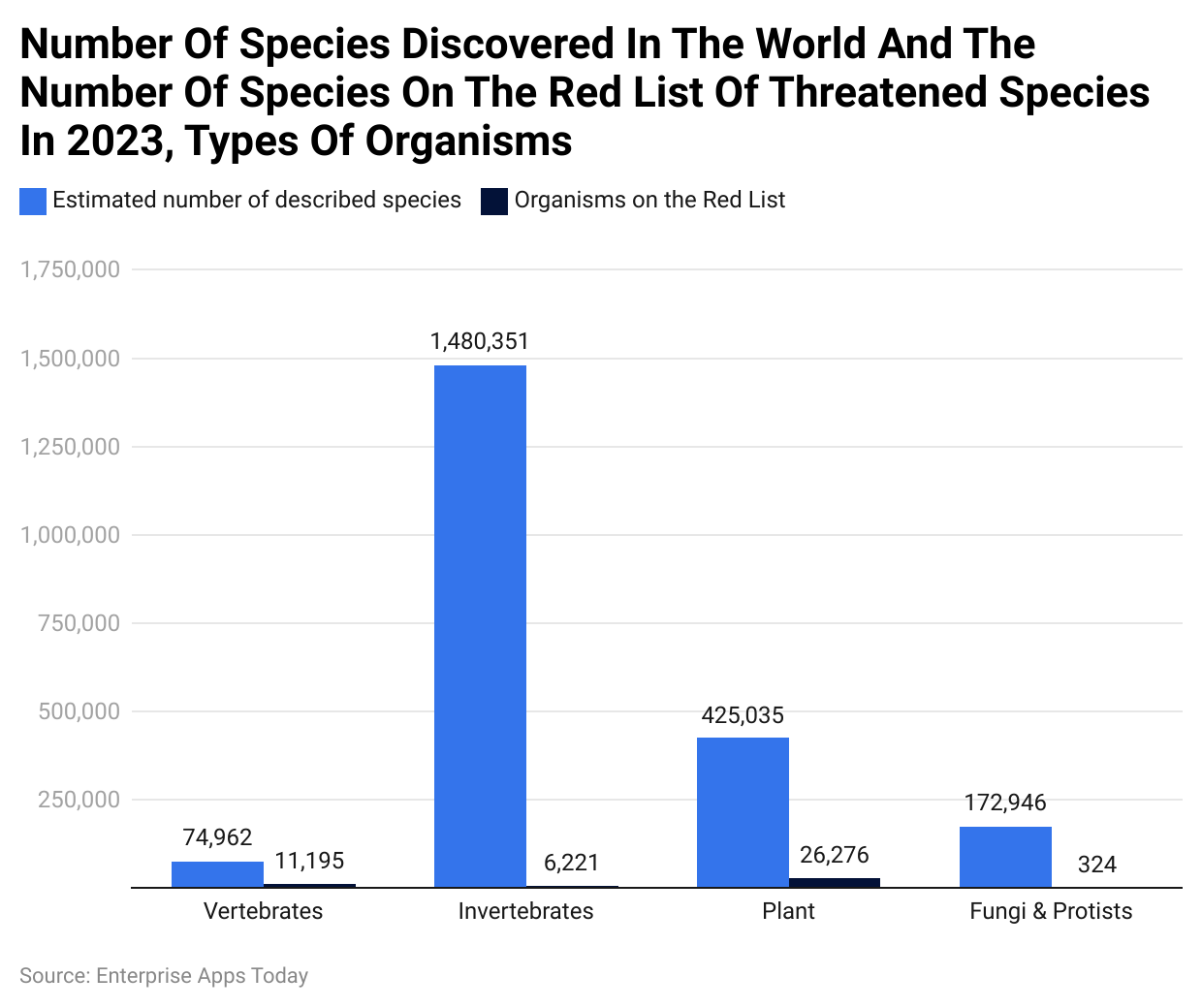 (Reference: statista.com)
(Reference: statista.com)
- Around the world, as of today, 74,962 vertebrate and 1,480,351 invertebrate species have been discovered, of which 11,195 vertebrates and 6,221 invertebrates have been identified on the Red List of threatened species in 2023.
- Similarly, more than 26,000 plants and 324 fungi and protist species out of 425,035 and 172,946 respectively have been threatened.
Endangered Species Statistics By Risk Of Species Extinction Worldwide Due to Global Warming
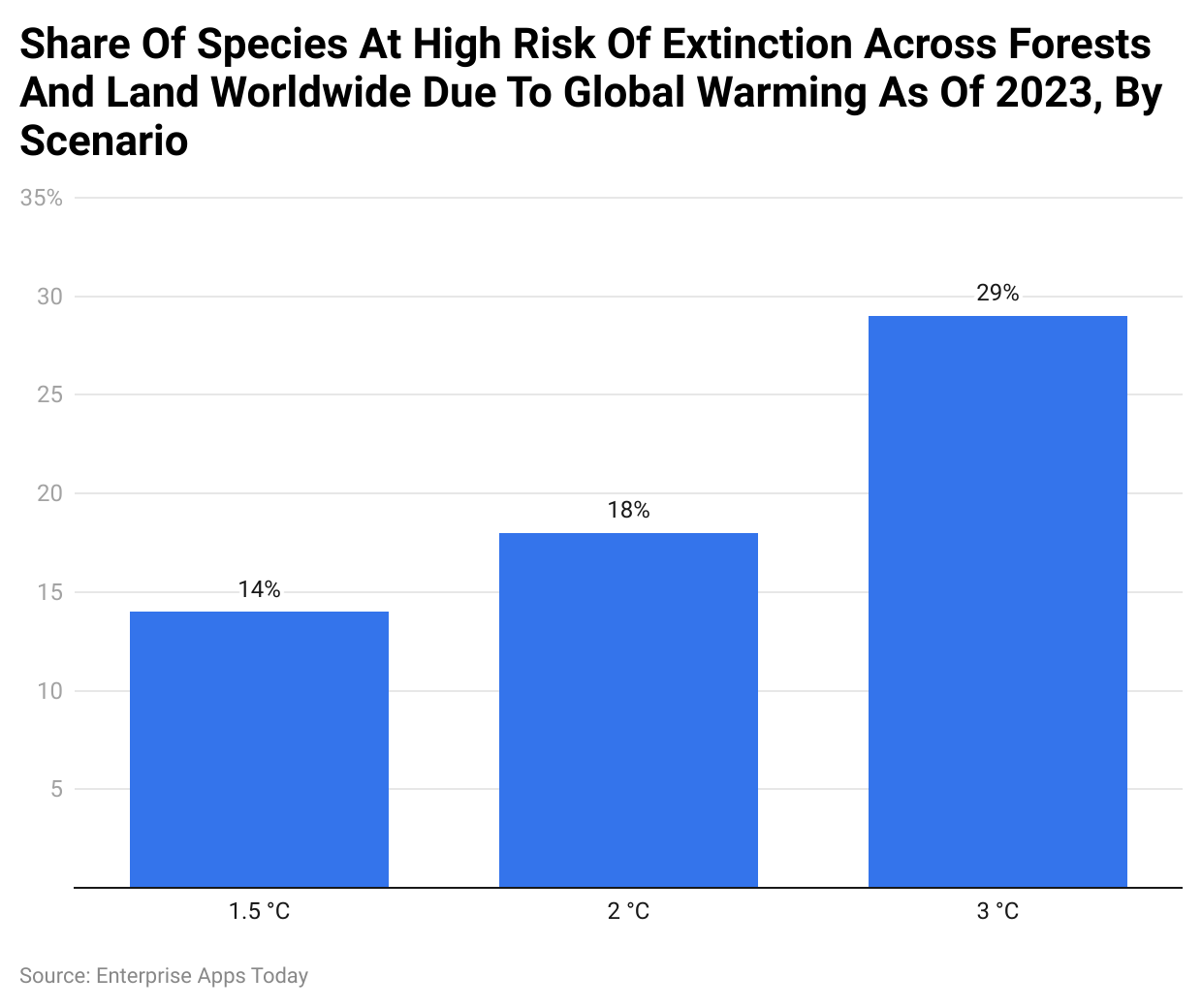 (Reference: statista.com)
(Reference: statista.com)
- Endangered Species Statistics 2023 by global warming state that there is a high risk if the temperature reaches 3 degrees Celsius, it will lead to 29% of extinction in forest and land areas around the world.
- Further projections said, even if the temperature reaches 2 degrees or 1.5 degrees Celsius, it is likely to increase the risk of extinction by 18% and 14% respectively worldwide.
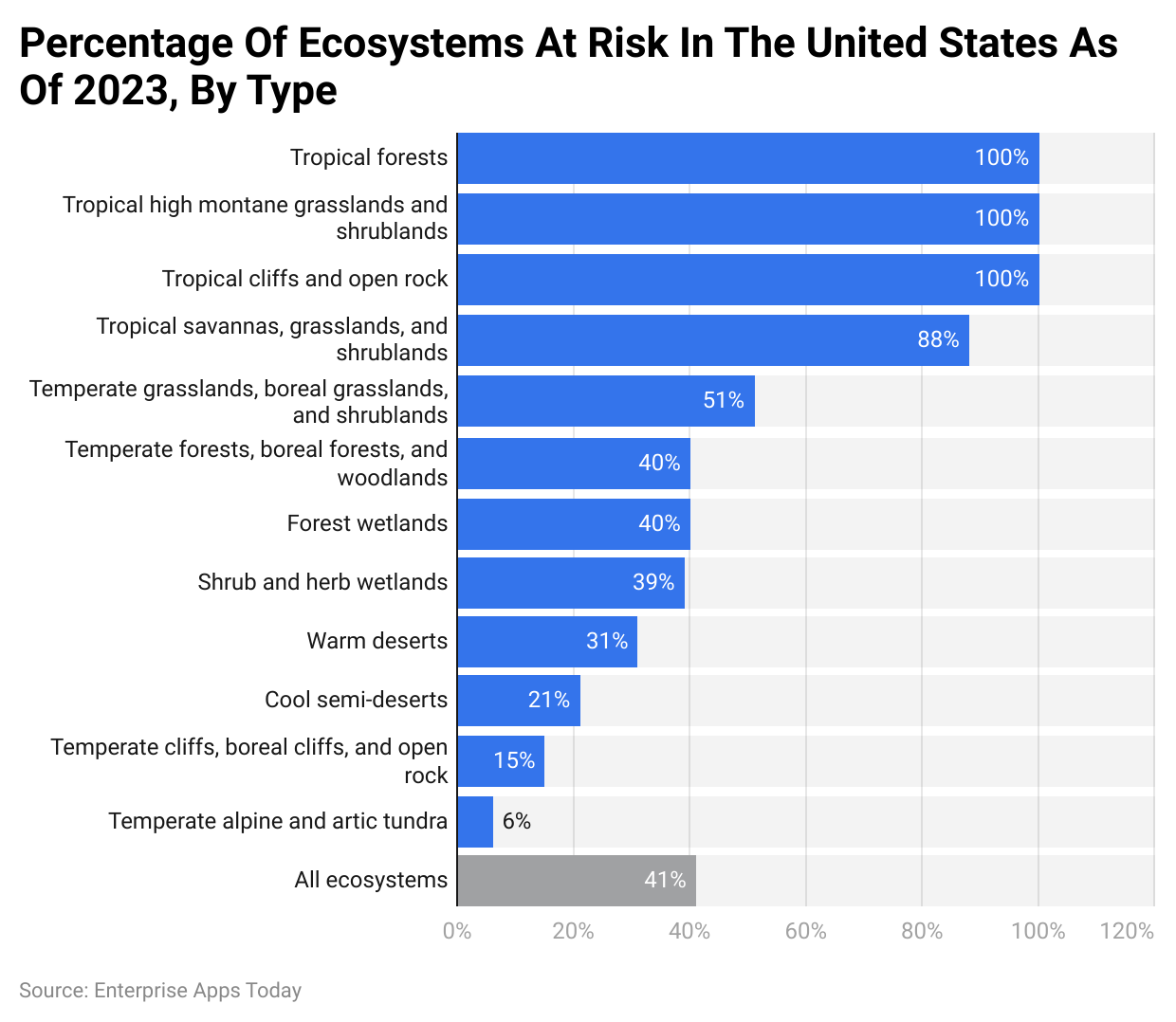 (Reference: statista.com)
(Reference: statista.com)
In 2023, the top 3 high-risk ecosystems in the USA were tropical forests, tropical high montane grasslands and shrublands, and tropical cliffs and open rock with a 100% rate of risk. All types of ecosystems are at a high risk of 41%.
Other types of ecosystems in the list included are as follows
- tropical savannas, grasslands, and shrublands (88%)
- temperate grasslands, boreal grasslands, and shrublands (51%)
- Temperate forests, boreal forests, and woodlands (40%)
- Forest wetlands (40%)
- Shrub and herb wetlands (39%)
- Warm deserts (31%)
- Cool semi-deserts (21%)
- Temperate cliffs, boreal cliffs, and open rock (15%)
- Temperate alpine and arctic tundra (6%)
The Attitude Of Americans Toward Environmental Causes In 2023
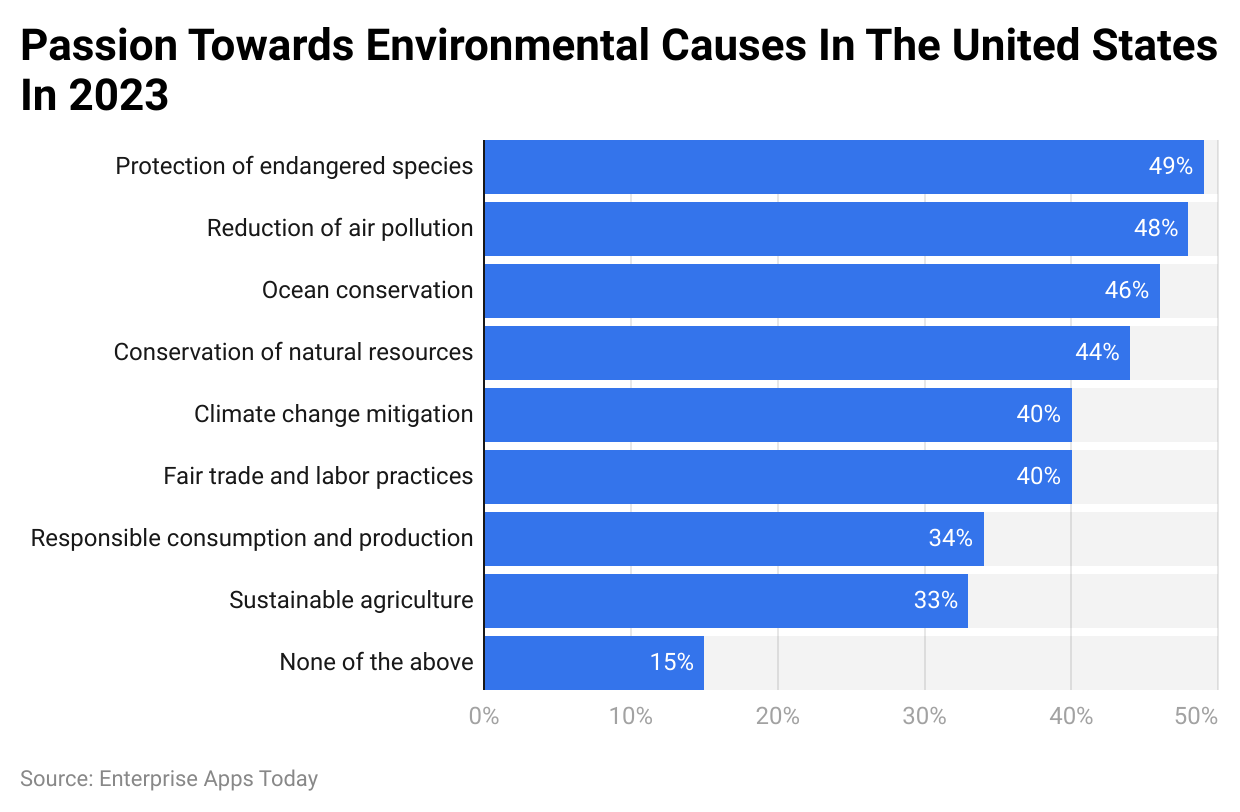 (Reference: statista.com)
(Reference: statista.com)
- According to the Consumer Insights Sustainable Consumption survey 2023, Statista published the answers to the question “Which environmental causes do you feel passionate about?” said the majority of Americans feel passionate about the protection of endangered species, contributing 49%.
- Reduction of air pollution and ocean conservation were the other two trending attitudes towards environmental causes, with 48% and 46%, respectively.
Endangered Species Statistics By Number Of Endangered Wildlife And Plant Species In 2023
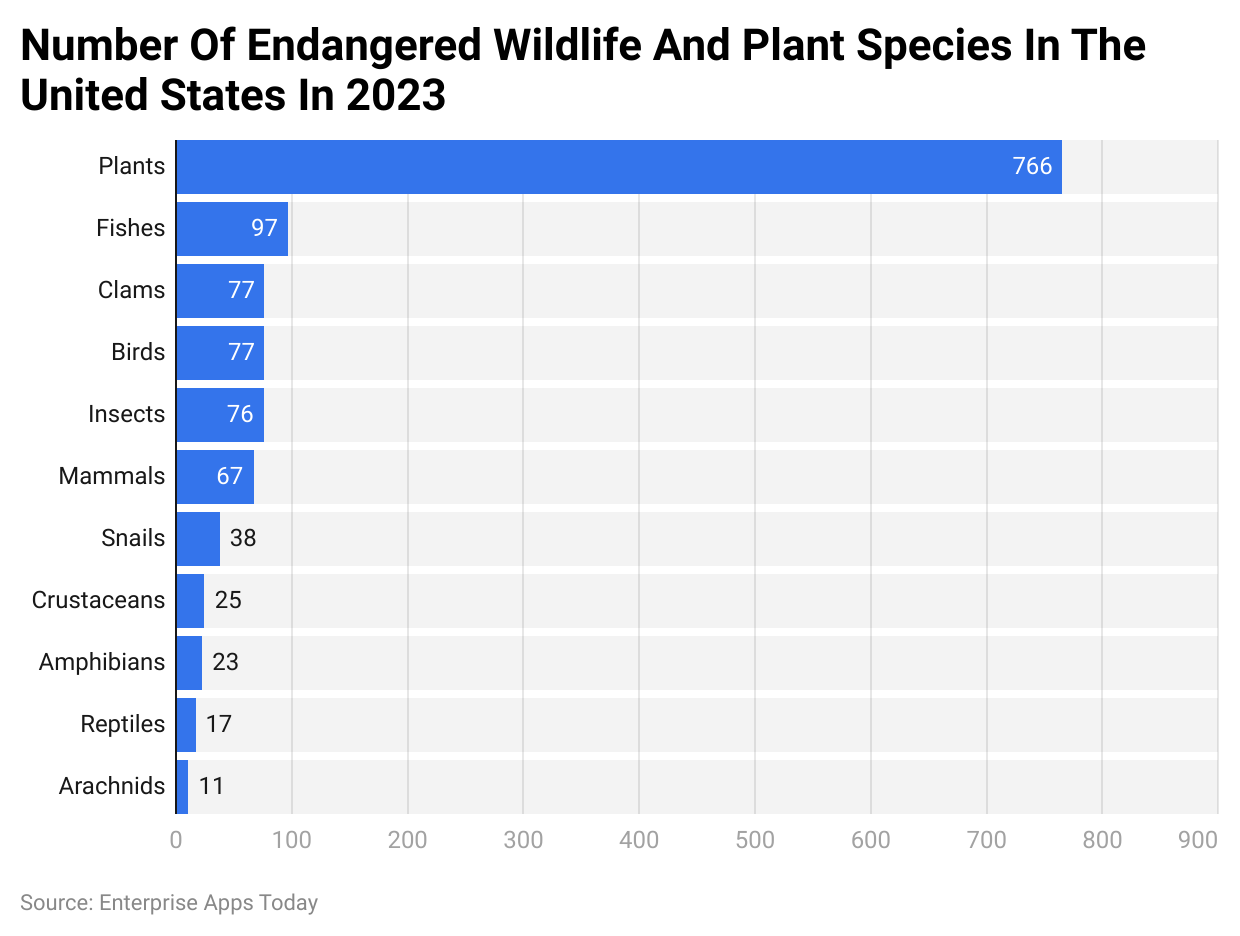 (Reference: statista.com)
(Reference: statista.com)
- As of 2023, in the USA plants, fishes, and clams species resulted in 766, 97, and 77 have been endangered.
- Other species in the list of most endangered wildlife and plant species included birds (77), insects (76), mammals (67), snails (38), crustaceans (25), amphibians (23), reptiles (11) and arachnids (11).
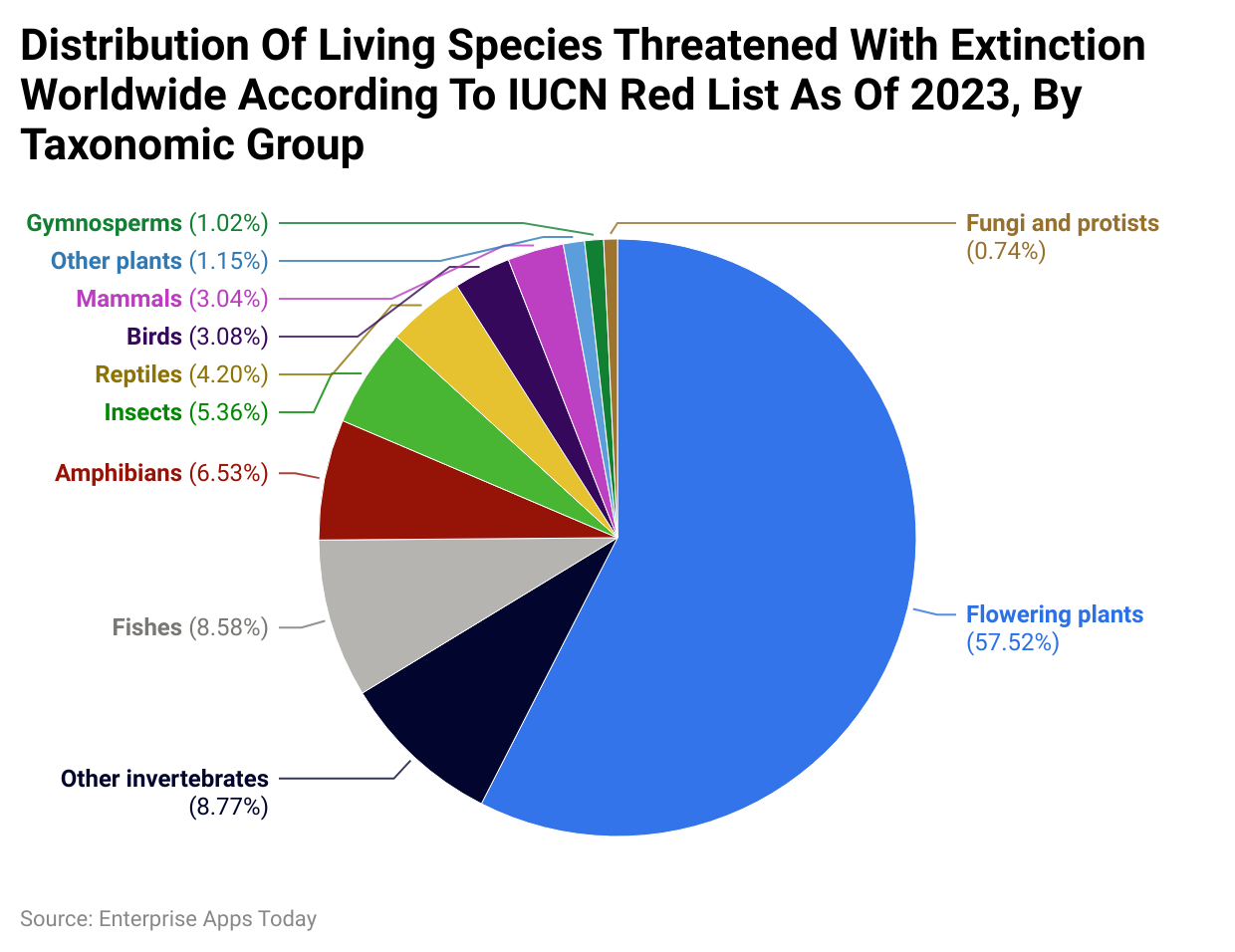 (Reference: statista.com)
(Reference: statista.com)
- The share of threatened species in the world is more for flowering plants resulting in 57.52%.
- Other invertebrates (8.77%), fishes (8.58%), and amphibians (6.53%) followed the highest share. Similar to other datasets of extinct or endangered animals, it also includes reptiles, birds, mammals, gymnosperms, fungi protists, and insects.
Endangered Species Statistics By Threats To Wildlife Populations By Region
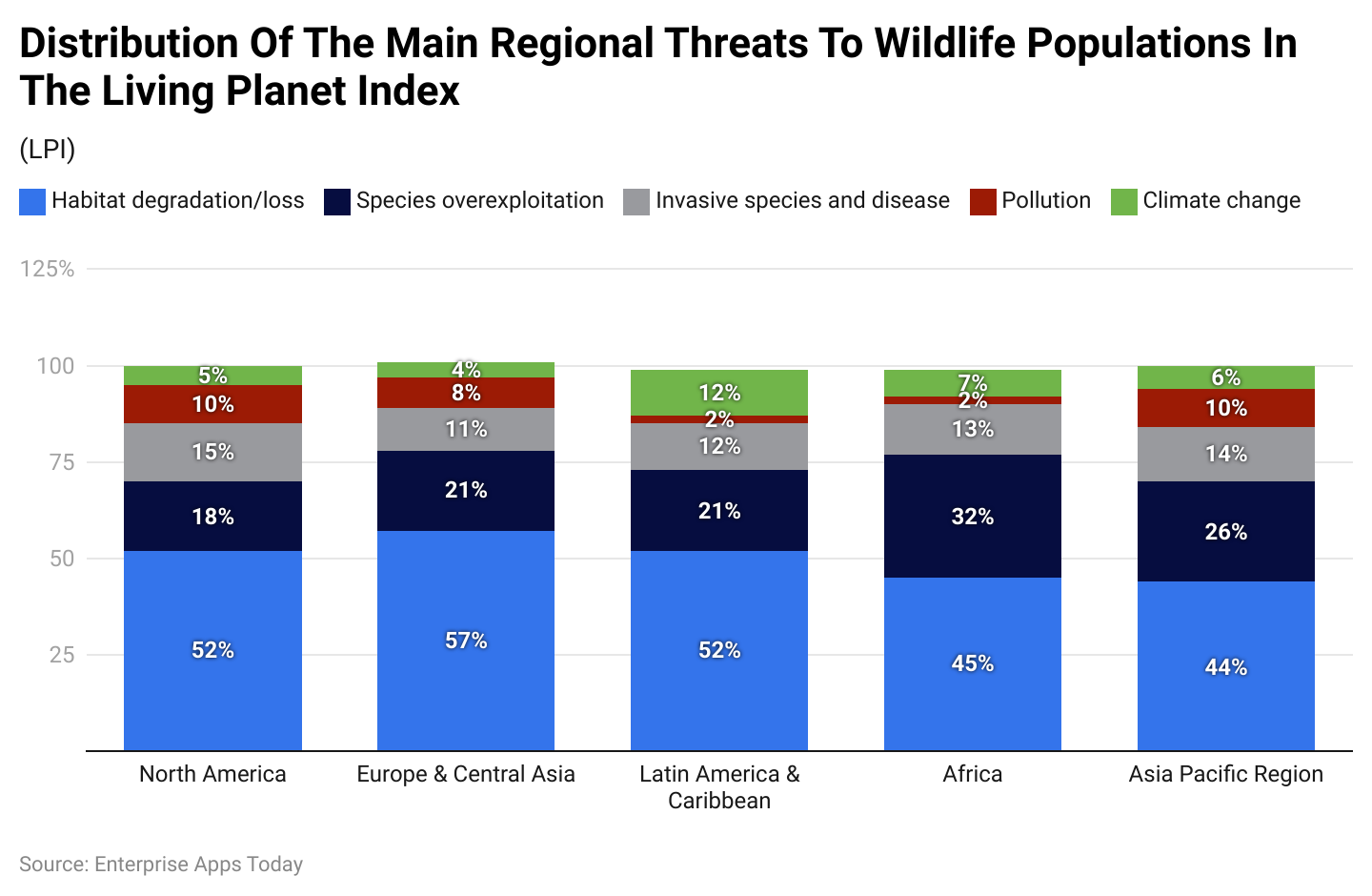 (Reference: statista.com)
(Reference: statista.com)
- As of 2023, in North America (52%), Europe Central Asia (57%), Latin America (52%), and the Caribbean highest percentage of threats to wildlife populations is due to loss or degradation of habitat.
- Whereas, in Africa and the Asian Pacific region species overexploitation is the leading cause contributing 32% and 26% respectively.
Endangered Species Statistics By Critically Endangered Species List
| Beluga | Black rhino | axolotl | American burying beetle |
| Chinese giant salamander | Bog turtle | California Condor | Chinese alligator |
| European mink | Great hammerhead | Indian vulture | Hooded vulture |
| European eel | Duskytail darter | Coral pink sand dunes tiger beetle | gorillas |
| Golden-eyed stick insect | European sea sturgeon | indi | Lesser Antillean iguana |
| Malaysian giant turtle | orangutans | Oceanic whitetip shark |
Mountain chicken |
| Malaysian giant turtle | Peacock tarantula | Red wolf | Peacock tarantula |
| North Atlantic right whale | Rice’s eagle | Rice’s whale | saola |
| Rusty patched bumble bee | Sunflower sea star | Variable harlequin frog | Western long-beaked echidna |
(Source: activewild.com)
What Are The Reasons Behind Species Extinction?
Climate Change:
- One of the leading causes of species extinction is climate change.
- Not all animals can handle extremely warm or extremely cold temperatures therefore death occurs in mass numbers that leads to species extinction.
- Today, increased global warming is an alarming cause that will soon become a reason for mass extinction.
Spread of diseases:
- Certain types of diseases are borne from the air and spread across all animals and humans.
- Bird flu is the most common type of disease in birds.
- There have been no records of COVID-19 effects on animals, but similar types can kill species all around the world.
Asteroid Attacks:
- Around 66 million years ago an asteroid that was bigger than Mouth Everest crashed with the earth and killed every living type of dinosaur on the earth.
- This type of attack is rare but not impossible.
- However, due to advanced technology, we can reduce losses from occurring due to such events to some extent.
Pollution:
- Pollution is a leading cause of health damage not only for humans but animals as well.
- Today’s situation states that there are more vehicles than total members in the family.
- The trend of every family member owning a vehicle is leading to increased pollution, affecting the health of humans as well as animals.
Loss of habitat:
- Due to modernization, industrialization, and increased demand for houses, we are cutting down forests, which are destroying many habitats like a kingdom of cards.
- Thus, many animals lose their homes. Their food supply is also cut off, which is also one of the many reasons for species extinction.
Conclusion
These Endangered Species Statistics show us how the world has turned and how human-led activities are causing the extinction of events. Between 2,000 to 10,000 species go extinct every year which is not a good sign of a healthy environment. Before us, the earth was home to animals and plants, and yet we are deliberately hunting animal species just for trophy purposes.
Although extinction is a natural event, scientists say that 99% of precious lives are taken away because of humans. Pollution, greenhouse gas emissions, and demolishing forests should be reduced to increase the population of endangered animals.

Joseph D'Souza started Coolest Gadgets in 2005 to share his love for tech gadgets. It has since become a popular tech blog, famous for detailed gadget's reviews and companies statistics. Joseph is committed to providing clear, well-researched content, making tech easy to understand for everyone. Coolest Gadgets is a trusted source for tech news, loved by both tech fans and beginners.











